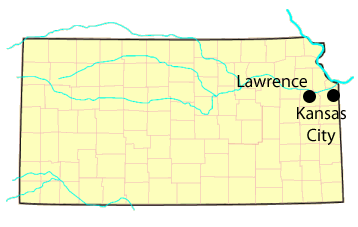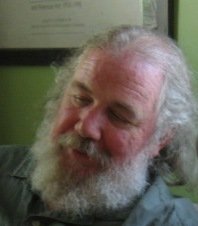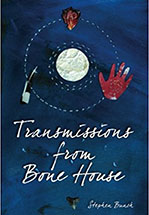
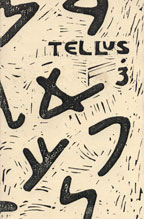
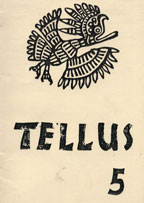
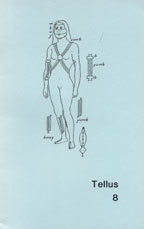
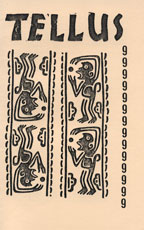
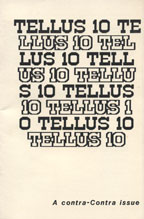
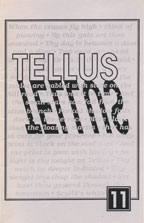
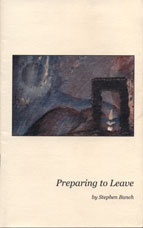
|
| Biography |
|
| |
As I write this, I’m completing my 63rd trip around the sun. I was born in Kansas City, Kansas, and, with the exception of one year spent in the Chicago area, have lived in Kansas all my life. Since few poets make a living from their poetry, I’ve found myself working at various times as a construction surveyor, college English teacher, copy editor, marketing director, database developer, and, currently, market researcher and program developer at the University of Kansas. An English major can do anything.
Inspired by Dylan’s “Blonde on Blonde” and Ginsberg’s “Kaddish,” I began writing bad but heartfelt poems in high school and sharing them with fellow poet and classmate Donald Levering. At the University of Kansas, I studied under Victor Contoski, who introduced me to such eastern European surrealists as Vasko Popa and Tadeusz Różewicz, as well as such American poets as Charles Simic and George Hitchcock, who also had kinship with the eastern Europeans. Although my meeting with him was brief, I also received invaluable advice from Robert Duncan, who gave me a reading list: H.D.’s imagist poems, Pound’s Personae and Guide to Kulchur, and Michael Alexander’s Earliest English Poems. I still recommend this reading list to young poets.
From 1978 to 1988, with encouragement from one of my heroes, poet/rock musician Ed Sanders, I edited and published a little magazine, Tellus. Most of the issues predated desktop publishing. Instead, I depended on an Adler portable typewriter, scissors, paste, and tape, the local copy shop, a “deep throat” stapler, and my kitchen table to produce the mag. It featured a mix of local and regional writers—some well-known, some not—and writers of some national prominence, such as Sanders, Edward Dorn, Jane Hirshfield, Paul Metcalf, and Jack Anderson. Among Kansas writers to appear in Tellus were Tom Averill (a couple of short stories and, I think, his first published poem), Victor Contoski, Harley Elliott, Steven Hind, Donald Levering, Denise Low, John Moritz, Elizabeth Schultz, and Fred Whitehead. It was a great experience, especially the correspondence with writers and the widening network that came through that activity. But it also, over time, crowded out my own writing. After getting poems published in a few magazines and anthologies, I stopped writing. Then, with new “day job” and family responsibilities, I quit publishing the magazine and entered my Rip Van Winkle phase.
In 2005, for unknown reasons, I woke up, resumed writing, and discovered the world of online poetry workshops and publications. That led to new relationships with other writers and editors and then to poems published in Autumn Sky Poetry, The Literary Bohemian, Fickle Muses, Umbrella, Touch, a Journal of Healing, and Mudlark.In 2008, I was fortunate to receive the Langston Hughes Award for Poetry from the Lawrence Arts Center and Raven Books. In 2010 and 2011 I had poems nominated for the Pushcart Prize, and in 2011 my first chapbook, Preparing to Leave, was published. But I’m still not quitting my day job.
---Written by Stephen Bunch
Return to Top of Page
|
|
|
Bibliography ( - housed in Thomas Fox Averill Kansas Studies Collection) - housed in Thomas Fox Averill Kansas Studies Collection) |
|
| |
Chapbook:
Editor/Publisher:
- Tellus (literary journal, 11 issues), 1978–1988
- Carpool, poems by Donald Levering, 1983
- A Kansas Sequence, poems by Victor Contoski, 1983
Articles:
- “Of Goat Glands and Gullibility: Boom and Bust with Dr. Brinkley,” Making Do and Doing Without: Kansas in the Great Depression, Division of Continuing Education, University of Kansas, 1983
- “Fear and Fervor: A Kansas Demagogue,” Making Do and Doing Without: Kansas in the Great Depression, Division of Continuing Education, University of Kansas, 1983
- “For a Quarter You Could Have a Good Time!” Making Do and Doing Without: Kansas in the Great Depression, Division of Continuing Education, University of Kansas, 1983
Essays and Reviews:
- “Wrong Name, Wrong Face, Wrong Place,” The Externalist (April 2007), 24
- Review of George Gurley, Jr., Fugues in the Plumbing, in New Letters (Winter 1982–1983)
- “Yeats, Thoreau, Dr. Williams, Jim Morrison, and Mr. Blake,” Sparks of Fire: Blake in a New Age (eds. Bogan and Goss), North Atlantic Books, Richmond, California, 1982, 217–218
- Review of Donald Levering, The Jack of Spring, in Tellus, 4 (Spring 1980), 42–43
- “Surveyor: Mind and Matter in the Work of Thoreau,” Kaw Valley Literary Review, I, 2 (Spring 1978), 63–74
- “Spies: Fragmented Vision in The Return of the Native,” Kaw Valley Literary Review, I, 1 (Fall 1977), 1–10
Radio Scripts:
- “Of Goat Glands and Gullibility: Boom and Bust with Dr. Brinkley,” Making Do and Doing Without: Kansas in the Great Depression, Division of Continuing Education, University of Kansas, 1983
- “Fear and Fervor: A Kansas Demagogue,” Making Do and Doing Without: Kansas in the Great Depression, Division of Continuing Education, University of Kansas, 1983
- “For a Quarter You Could Have a Good Time!” Making Do and Doing Without: Kansas in the Great Depression, Division of Continuing Education, University of Kansas, 1983
Other Stephen Bunch work has been published in: The Literary Bohemian, The Journal of Healing,
The Externalist, Fickle Muses and many other journals.
Poetry List (a more complete list of Bunch's work)
Return to Top of Page |
|
|
| Writing Samples |
|
| |
Dodge City Out
after Ed Dorn
Wind turbines spread in a grid
near Spearville—parallel strands
of red lights flashing
in unison against a broken
Saturday night of lightning
moving into Dodge.
On Sunday morning the Crystal Cathedral
rises in straight lines and angles
on a television screen in the Comfort Inn motel
on the Boulevard of Wyatt Earp,
another straight shooter gone askew.
The minister delivers a sermon
on the geometry of salvation,
the busy intersection of the cross,
where the horizontal line of daily intention
crosses the vertical of hope and redemption.
Outside Ulysses a neon Pegasus glows.
At every highway junction, signs announce feeders.
On US-56, the fed fill pens in a stinking patchwork.
At the crossroads, seller and buyer
meet, feeder and fed, sinner and redeemer,
briefly, in passing, joined at cross
purposes before moving on.
Plains people know the ease
of straight lines and right angles—
the appearance of management, control—
until they vanish in the slow
imperceptible curve of the horizon.
And somewhere between Ulysses
and Walsenberg, on a ragged line
of antelope and chaparral,
they learn to live
with the apparition of mountains.
In the mountains and valleys
of northern New Mexico, the churches are packed
with mud and curve out from the earth.
But in a rectangular, windowless morada
near Taos the penitentes stripe themselves,
straight bleeding lines on shoulders
and backs to steer them off
the wayward path, the jag
and curve of mountain, the road that twists
into valley’s comfort, the easy sprawl
of cottonwood, the burst of mountain lupine.
---The Literary Bohemian, February 2010
News from the Ultra Deep Field
Odysseus drinks alone
in a bar in Topeka.
Over the horizon of his glass,
the television hovers, muted,
flashing pictures from the Hubble,
images from the Beginning
of Time, says the crawler
along the bottom of the screen.
The one-eyed bartender
winks knowingly. Or blinks
unwittingly. Who can tell?
The universe expands as Odysseus
chews an ice cube,
but the distance on the interstate
from Salina to Kansas City
does not change,
and truckers travel through
the void of a prairie night
not hearing the sirens.
On a plateau in New Mexico,
the Very Large Array
listens for news of the Wanderer,
somewhere between Ilium and Ithaca,
somewhere beyond the gradual
ascent of the high plains,
sometime before last call.
---Fickle Muses (February 2007)
March First—A Marsh—First Mark
Take a canvas.
Put a mark on it.
Put another mark on it.
(Jasper Johns, “Sketchbook Notes,” 1965)
Every automobile shines today
on parade in the sun
like salamanders rising glistening from the mud.
A half mile off the asphalt
an early frog floats belly up
amid the latest procession
of polliwogs making
their wiggling marks in the bog.
I send my messenger before thy face,
who shall prepare thy way, the voice
of one crying in the wilderness—
Otters reappear after one hundred years,
their coats finally worth less
than the real estate they navigate,
their tracks like hieroglyphics
with a long brushstroke of tail,
while overhead the vapor trails
of other travelers dissipate
and faces fade with distance.
Prepare the way of the Lord, make
his paths straight—
Geese startle and rise to the flyway.
Maybe the time is fulfilled—maybe
the kingdom of God is at hand.
Mud-crusted shoes dry by the door.
Bamboo chimes rattle under the rain gutter.
Later today we shall eat off white plates
lined up on a table by sun-filled windows
and listen to the south wind blow the sky away.
--- From Preparing to Leave, 2011
Here is a link to the publisher's Web page for Bunch's chapbook: http://thelivesyoutouch.com/touchjournal/Publications/Bunch.html
Return to Top of Page |
|
|
Author Interview
|
|
| |
Q. What made you choose poetry over any other style of writing?
I don’t have a clear recollection of “choosing” poetry over other modes of writing. In high school English, I enjoyed poetry—especially Blake and Whitman. When I returned to writing in 2005, initially I wrote prose—fiction, I suppose, sort of off-the-wall imaginative riffs—but then I returned to the poem.
Q. How do you think that being where you lived influenced your writing?
I don’t know. One of the things I’ve learned from such writers as William Carlos Williams, Charles Olson, Victor Contoski, and others is a kind of correlative to the old “write what you know” axiom. Writing is processing the inputs, and the inputs are local phenomena, what I’m reading, what I’m feeling. For me, writing is an attempt to figure out what all these inputs mean, looking for connections that help me make sense of the world I’m in. I realize that’s abstract. Early in my writing I think I was self-consciously local—place names, the weather, current events. Those elements still appear in my writing, but they’re less forced to convey meaning than to be points of reference in a thought process. Hmm. That’s pretty abstract too. I’ll go with my original answer: I don’t know.
Q. Who would you say are some of the biggest influences in your writing career?
I’m not sure I’d call it a career, but I’ve already mentioned several: Don Levering, Victor Contoski, Robert Duncan, Ed Sanders—writers I’ve met briefly or known personally for decades. The list of other poets is too long for this space, but a few that I keep returning to are Pound, H.D., Edward Dorn, Emily Dickinson, and W.S. Merwin.
Q. If you weren’t a writer, what would your second choice have been for a career?
As indicated earlier, I don’t consider my writing a career. I know that with the explosion of MFA programs, there is now something like a career path for poets, usually involving teaching, but I think writers run a risk of solipsism or disconnection if they pursue that path. Having said that, I admit that I never planned my career. Rather, I seem to have bounced from one fortuitous work experience to another, in the process learning a number of skills, everything from setting up and using a theodolite to teaching freshman English to performing recency-frequency analyses of customer databases.
Q. How would you define your writing?
I resist the temptation to define, as defining turns the thing into a commodity, something to be bought and sold. Writing poetry is like scratching an itch. That is, it’s a response to stimuli. It’s my way of trying to make sense of all the “inputs,” a way to filter and focus, a way of bringing at least the illusion of order to my world. Kant wrote that art is purposive without purpose. Heidegger wrote that art is the act of making a world out of earth. Ed Dorn wrote that the poem is “an instrument of intellection/thus a condition/of the simultaneous.” Ed Sanders celebrates homo ludens. I subscribe to all of these views.
Q. What do you want people to get from your writing?
This question implies telos or intention in the writing. I rarely write with an end in mind, let alone any thought as to what a reader might derive from it. At the risk of sounding flippant, I don’t want (i.e., intend) a reader to get anything from my writing. I know there will be some things in the writing that will appeal to some readers (e.g., sounds, rhythms, perhaps a surprising turn), but those things are (at least consciously) not done for the reader’s benefit, but rather are simply a part of the process of discovery.
Additional interview questions:
http://networkedblogs.com/wZfua
Return to Top of Page |
|
|
| Links |
|
| |
Other poems can be found at the following links:
Steve Bunch wrote: "A new collection of my cranky musings is out on Mudlark."
Return to Top of Page |
|
|
|

